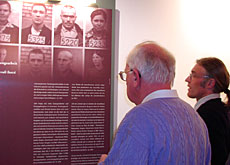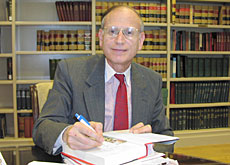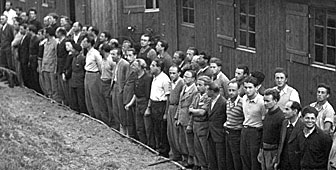Nazi dealings push aside William Tell

A dark chapter in Switzerland's history is the focus of a new exhibition in Schwyz - a town whose museums normally highlight more heroic episodes.
“The Bergier Report” is a multimedia presentation of the last year’s findings of a historical commission studying Switzerland’s role during the Second World War.
The exhibition at the Forum of Swiss History in the town of Schwyz, the capital of the canton of the same name, is divided into two sections.
A high fence – symbolic of the decision by the Swiss authorities to seal off the country’s borders during the war – separates the areas.
The only way to see the other half of the exhibition is by passing through a door opening onto a bleak and narrow passageway.
Turned away
Once through the door, excerpts from the commission findings remind museumgoers of Switzerland’s controversial refugee policy.
Tens of thousands of people fleeing Nazi Germany were turned away at the Swiss border or were deported.
There are audio recordings, photographs and documents which paint a picture of a country vigorously engaged in defending its neutrality while doing business with the Nazi regime and turning a blind eye to its atrocities.
At the same time it seeks to reflect the anxiety the Swiss themselves felt during the war, partly in an effort to explain why they put up with the authorities’ controversial policies.
Fear of war
Everyday household items including a cookbook showing housewives how to prepare nutritious meals from the permitted rations are displayed alongside a soldier’s helmet and gas mask.
“Switzerland was surrounded by Nazi states and the people were frightened,” says Stefan Aschwanden, curator of the Forum.
“People were afraid that the war could spill over into Switzerland.”
The exhibition is a stark departure for a museum whose permanent exhibition highlights Swiss history between the 14th and 19th centuries.
William Tell
The upper floors of the museum are dedicated to displays showing how life developed in Switzerland over the centuries, with a generous sprinkling of depictions of William Tell and other medieval Swiss heroes.
Schwyz, as one of the three founding cantons of the Swiss confederation, is full of reminders of its proud past.
A painting of the famous battle of Morgarten – when the Swiss confederates defeated the Habsburgs in the early 14th century – covers one side of the town hall.
Just down the road, the founding charter of the confederation dating from 1291 is housed in the Museum of Swiss Charters.
The display cases in this museum are dwarfed by a large mural portraying Switzerland’s proud founding fathers swearing an oath of mutual defence.
Ironically, the painting was commissioned at the beginning of the Second World War when the legend of Tell and associates was used for propaganda purposes to strengthen the will of the nation in the face of a real or perceived Nazi threat.
Another example of this is a late 1930s film depicting the victory at Morgarten, which is shown as part of the permanent exhibition at the Forum of Swiss History.
Less-than-heroic
The new temporary exhibition at the Forum sheds light on Switzerland’s equally successful, but less-than-heroic effort to survive an external threat.
Aschwanden says the Bergier Report exhibit is not out of place at the museum.
“A lot of people in the country, even when they don’t agree with all the findings contained in the Bergier Report, have congratulated us,” he said.
“It’s the duty of the museum to offer a platform for discussion,” he continued.
“I think it is not only absolutely right but also necessary that the discourse of history and how history functions is also extended to our recent past,” added David Streiff, head of Switzerland’s Federal Office for Culture.
There was no intention to turn the Bergier report into an exhibition when the historical commission concluded its work a year ago.
Many on the political right who opposed the setting up of the historical commission in the first place, and disagreed with its findings, expressed the hope that the report would be quickly forgotten once the commission concluded its work.
That hasn’t been the case. After Schwyz there are plans to move the exhibition to the Swiss national museum in Zurich.
swissinfo, Dale Bechtel
The Bergier Commission was set up in the mid-90s during the controversy surrounding Switzerland’s role during the Second World War.
The job of the commission, made up of an international team of historians, was to investigate Switzerland’s refugee policy, dormant bank accounts and the country’s financial dealings with Nazi Germany.
The commission published 25 separate studies.
Bergier Commission released its final report in March 2002.
Key conclusions have been turned into an exhibition in Schwyz.
The exhibition runs until May 4.

In compliance with the JTI standards
More: SWI swissinfo.ch certified by the Journalism Trust Initiative



You can find an overview of ongoing debates with our journalists here . Please join us!
If you want to start a conversation about a topic raised in this article or want to report factual errors, email us at english@swissinfo.ch.